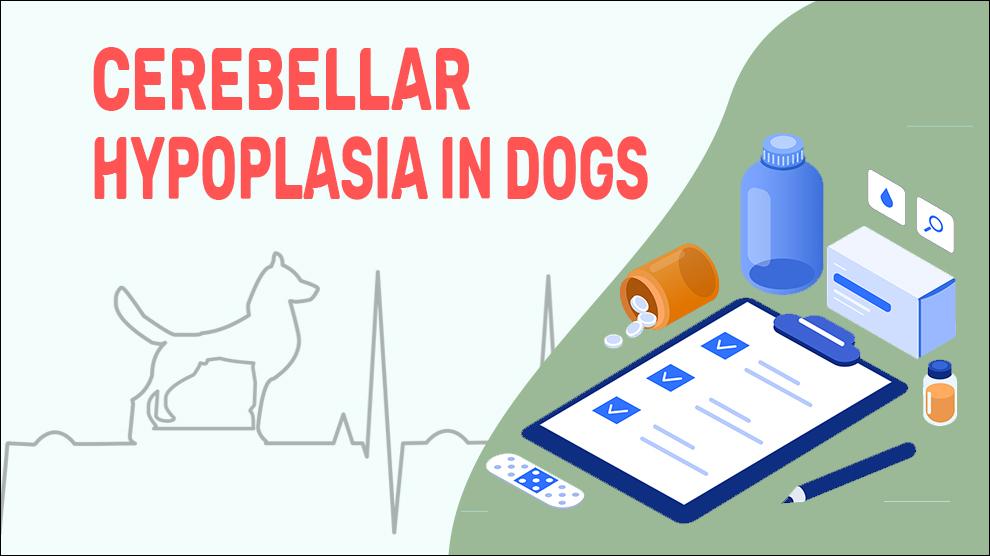What Is Cerebellar Hypoplasia In Dogs?
Hypoplasia means shortened or underdevelopment of an organ or apart. Cerebellar hypoplasia (aplasia) in dogs is an autosomal, recessively inherited, morphological cerebellar abnormality in which the dog's cerebellum is not completely developed or smaller than usual. This happens when pregnant dogs are vaccinated against or infected by specific infectious diseases as cerebellar germinal cells and neurons are destroyed in utero.
This is in contrast to cerebellar abiotrophy, which represents a collection of postnatal syndromes that are progressive. They usually involve thinned cerebellar folia and a primary loss of Purkinje neurons. Mostly, the abiotrophy is noticed within the first few months of life, but in some dogs, it may not be seen for a few years.
The cerebellum is the part of the brain that is accountable for fine-tuning motor movements, eye movements, and maintaining a dog’s balance by detecting shifts in balance. Mostly, the condition is noticed within the first few weeks of life as the pet begins to be more active - jerky movements, tremors and Incoordination may indicate the condition.
There is no treatment for this disorder; however, the quality of life in affected dogs is not compromised when the pet owners understand the special needs of the dog. This disorder can look similar to other conditions, so it is essential to discuss the concerns about your pet with the veterinarian.
Symptoms Of Cerebellar Hypoplasia In Dogs
- Ataxia and Dysmetria
- Stiff walking
- High stepping
- Falling
- Overreaching and overstepping
- Intention tremors
- Disequilibrium (the sensation of being off-balance).
- Nystagmus
- General head bobbing
- Incoordination
- Hyperactivity and Aggression
- No menace reflex
Treatment Options For Cerebellar Hypoplasia In Dogs
There is no specific cure for cerebellar hypoplasia but it can be treated to relieve symptoms.
- Pain medications such as carprofen (Novox or Rimadyl), firocoxib (Previcox), grapipant (Galliprant), deracoxib (Deramaxx), meloxicam (Metacam) etc.
- Anxiety medications such as Alprazolam (Xanax), buspirone, and Clomipramine (Clomicalm).
- Protecting cells from damage- Coenzyme Q-10.
- Improvement of nerve impulse transmission - carnitine.
Home Remedies For Cerebellar Hypoplasia In Dogs
Proper treatment and careful home care can help dogs with hypoplasia maintain a quality of life for a reasonably long time.
How To Prevent Cerebellar Hypoplasia In Dogs?
- Cerebellar hypoplasia has been linked to an inherited autosomal recessive gene. Therefore, the best method of prevention is responsible breeding practices.
- Breeders should keep track of lineages with a lower-grade form of this disease and stop breeding the dogs.
- Parasite Preventatives: Provide adequate flea and tick preventatives such as heartworm preventatives.
- Make sure that all vaccinations are given promptly and boosted before the dog gets pregnant.
- Prevent access to any household or garden toxins.
Affected Dog Breeds Of Cerebellar Hypoplasia
Irish Setter, Wire Fox Terrier, Chow Chow, Boston Terrier, Bull Terrier, Airedale Terrier, Staffordshire Terrier, Bernese Mountain Dog, Border Collie, Brittany Spaniel, Bull Mastiff, English Springer Spaniel, English Pointer, German Shepherd, German Boxer, Gordon Setter, Labrador Retriever, Puppies
Causes And Diagnosis For Cerebellar Hypoplasia In Dogs
- Causes:
- Congenital in certain breeds.
- Intra-utero infection such as brucellosis.
- Malnutrition during pregnancy.
- Environmental toxins.
- Mortality:
Young dogs have the highest mortality rate as they are unable to get nursed. Although there is no cure, cerebellar hypoplasia is usually not fatal.
- Diagnosis:
- Complete physical exam
- Dog’s reflexes
- Biochemical analysis, Complete blood count
- Bacterial and fungal cultures
- Cerebral spinal fluid analysis
- MRI
- Prognosis:
There is no cure for cerebellar hypoplasia. This is a congenital, non-progressive neurodegenerative disease. Treatment is usually supplemental and is based on the dog's symptoms.
When To See A Vet For Cerebellar Hypoplasia In Dogs?
Contact your vet right away, if you notice any of the following:
- Puppies that are Unable to walk/walk with goose-stepping/falling.
- Muscle tremors
- Stiff walking
- Falling
- Overreaching and overstepping
Food Suggestions For Cerebellar Hypoplasia In Dogs
Foods to avoid:
- Avoid fatty foods or high in fiber.
- Cutback on greasy, oily, spicy foods.
- Avoid crunchy or chewy snack foods.
- Avoid dairy products like milk, yogurt, etc.
- Bread products and roasted nuts.
- Avoid tougher meats.
What to feed:
- Smaller, more frequent meals of high-quality, high-calorie food.
- Choose softer foods such as mashed, soft, or pureed foods.
- Moisten/soften foods with chicken broth, gravy, or butter.
- Finely chop up veggies, chicken, or meat.
- Watch the salt intake of dogs such as from canned soups or frozen meals.
- Add calcium-rich foods and supplements such as broccoli, salmon, Sardines, and Dark leafy greens.
Conclusion
Although Cerebellar hypoplasia is not curable, most pets require months of medication and special feeding. Dogs may require physical therapy depending on the severity of the disease. Physical therapy is done to enhance muscle strength. With the right supportive care and medications, pets can live a longer, quality life.

















